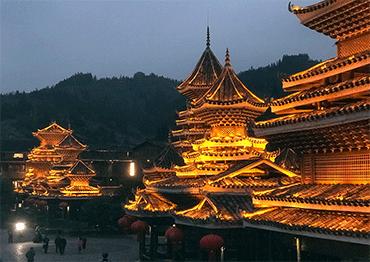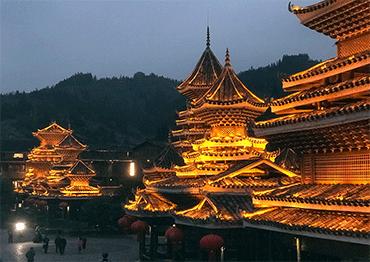Congjiang is the small administrative seat of Congjiang County in Qiandongnan Miao and Dong Autonomous Prefecture of Guizhou. Despite its relatively small size, Congjiang is connected by a high-speed rail line to major urban centres including Guiyang, Guangzhou, Chongqing and Chengdu. Best of all, Congjiang is as little as 40 minutes by train from Guilin, Guangxi Zhuang Autonomous Region, making it an excellent stopping point for any cultural tour of the region. Congjiang itself has only limited attractions for visitors. However, the areas surrounding Congjiang offer an abundance of opportunities for visitors to become intimately acquainted with some of China’s most unique agricultural landscapes and minority ethnic cultures.
Around 80 kilometers from Congjiang visitors can reach Jiabang Rice Terraces, which are among the most beautiful and authentic rice terraces in China. These terraces maintain a traditional pest-control ecosystem through the natural partnership of farmers, ducks and fish. The beauty of the terraces changes throughout the year, as the seasons dictate the life cycle of the rice. In the winter the terraces are covered in snow, resembling a mystical Chinese Narnia. As the cold departs, the terraces become dazzling reflective mirrors, as the sun strikes and reflects off the staggered pools.
Soon, as the heat builds, the entire valley is overwhelmed by the luscious and luminescent green of the early rice shoots, which transform into a deeper regal green as the weeks pass and the crops grow. Finally, as the harvest draws near, the terraces shimmer with a rich golden yellow, as the cooling autumnal breeze helps the tall rice to gently sway.
However, the most popular attractions in and around Congjiang are not necessarily the beautiful fields, but rather the farming villages that sustain them.
Among the most famous is Basha Miao Village, only eight kilometers from Congjiang railway station. Basha Miao Village is notorious for having a unique right to gun ownership. The right to hold guns was granted to the village in recognition of their traditional and historic culture. As home to “the last gun-toting tribe in China,” Basha Miao Village receives a steady stream of visitors, who are welcomed at the village gate by a regular shooting celebration. Upon entering, visitors pass a gigantic ceremonial tree, which was planted to honor former Chinese leader Mao Zedong upon his death. The village is rather small but has a second famous tradition – cutting hair by sickle. Every day tourists sit en-masse around the village square to watch a music and dance performance, followed by the main spectacle, where a member of the audience is selected to have their head shaved into the local fashion by a senior tribal member wielding a large and very sharp sickle. While the haircut might not be to everyone’s style, it is certainly one of the most unique contexts for a haircut in the world.
Moving on, there are countless ethnic minority villages and towns within Congjiang County that are worth visiting. These include Xiaohuang Dong Village, globally renowned as the home of Dong ethnic singing. Dong singing involves huge choral groups whose singing emulates and simulates the sounds of nature. Meanwhile, Zengchong Dong Village is famous for its stunning Zengchong Drum Tower, which is over 340 years old and rises 11 stories (25 meters) above the town. Zhanli Dong Village sits along the river and is well known for its embedded traditional superstitious culture, including the provision of mysterious therapies. Huanggang Dong Village is a stunning traditional village, which feels more primitive than many of the others. The residents of Huanggang are famous for praying for rain by shouting at the sky on June 15. Yintan Village is one of the most beautiful and peaceful villages in the area, home to both Miao and Dong people. The village sits in peace surrounded by luscious green vegetation most of the year, although during the harvest season the area is a golden rich yellow. Finally, and more controversial, is a trip to Tingdong Dong Village, which is famous for its bullfights. This is certainly a unique and authentic traditional experience, although not an event everyone would wish to attend.
However, the closest tourist destination to Congjiang city center, and arguably the most interesting settlement in the region, is Zhaoxing Dongzhai Town. Officially, it sits in Liping County, yet it takes less than 10 minutes by a car from Congjiang Station. Town officials forbid non-locals from entering in private transport, so there is a park and ride system.
Once visitors reach the town they are welcomed by one of the most attractive Dong-style covered “wind-rain bridges” in all of China. The town also boasts several very tall and ornate drum towers. Despite the town’s notoriety as an attractive destination for tourists, it is clear that it is an authentic, living, working home for a population that cherishes their traditions, cultures and customs. Come rain or shine, there are almost always groups of locals playing traditional games on the benches underneath the drum towers, which form the center of the various village squares. Likewise, visitors can hear locals playing traditional musical instruments, and if they are lucky, visitors will see the village elders teaching small children the secrets of traditional songs, crafts and music. All this hard practice pays off during celebrations, such as Chinese New Year, when the entire town bursts into life with street dancing, music and celebration.
The town’s ornate wooden architecture is fascinating, and benefits from inspection during daylight hours, when one can clearly see the fine craftsmanship. However, it is only at night that Zhaoxing Dongzhai Town comes to life. As the sun sets, warm glowing evening lights start to twinkle from within the wooden houses and they begin to reflect with a shimmer in the canals below. With such gentle lighting, the medieval streets take on a mystical edge. At the same time the streets fill with wood smoke from traditional chimneys and the mouth-watering smells of home cooking. Thankfully for visitors, the town has countless small boutique homestays, which offer modern comforts, without the cold anonymity of a chain hotel. Likewise, there are plenty of small restaurants and bars, catering predominantly to local and traditional tastes, but with a few modern and international delicacies.
There is no avoiding the fact that Zhaoxing is a small and traditional settlement, more closely resembling a Harry Potter movie set. Yet, visitors should not be fooled into thinking that the town is dull or quiet. In addition to traditional evening concerts put on for visitors, the town’s center comes alive at night with lively and occasionally raucous live music bars, which are frequented as much if not more by locals than by visitors. Zhaoxing’s people may be traditional, but they also know how to have a good time.

 Old Version
Old Version

